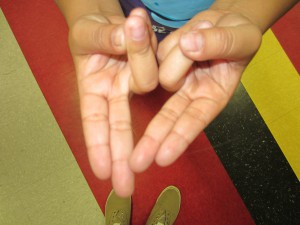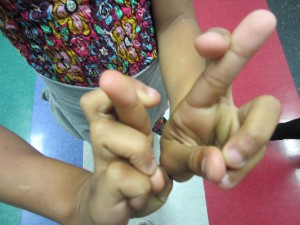CONTEXT
My informant shared this piece of folklore during a JEP folklore lesson, after my partner and I asked the first- and second-grade class whether they knew any games. My informant said later that the game can be played at school during recess or lunch, or at home. She told me that she had learned the game from her mother, who learned it from a friend when she (i.e., my informant’s mother) was in high school. The version she performed was an alternate version of what my informant had learned: that “real” version had other words in place of this version’s “iced tea,” but my informant could not remember that version. When I asked her why she likes the game, she said, “It’s fun.”
MATERIAL
Lemonade is a game with two players, who clap their hands together and chant. Each player slaps her right hand against the other’s upturned left and vice versa, and then pushes both palms against the other’s palms (a la “patty-cake”), and then claps her hands together three times. These actions are repeated. Meanwhile the players chant, “Lemonade, iced tea, Coca Cola, Pepsi,” to the rhythm of the claps and slaps: “Lemon” (slap) “ade” (push), (clap clap clap), “iced” (slap) “tea” (push), (clap clap clap), et cetera. This clapping/slapping and chanting pattern is repeated one time, without the three-clap punctuations, and then each player says (and mimes): “Turn around, touch the ground, kick your boyfriend outta town, freeze!”
Here is a video example of “Lemonade,” performed by my informant and her friend:
ANALYSIS
This piece shows how thoroughly corporate messages permeate children’s culture. The chant places brands like “Coca Cola” and “Pepsi” alongside generic beverages like “iced tea” and “lemonade,” thereby breaking down the barrier between institutional and colloquial forms. We see that corporate messages have invaded children’s folklore, but in turn, children are remixing corporate symbols for playful purposes. As my informant explained, “It’s fun.”
The chant also suggests a romantic norm, by assuming that the female players have a “boyfriend,” implying a monogamous heterosexual relationship. But in its specific advice about how to navigate that relationship—to take a hardline approach; to “kick [her] boyfriend outta town”—the chant is more unconventional, suggesting an opposition between the sexes, with females having more power. “Lemonade” empowers girls.


